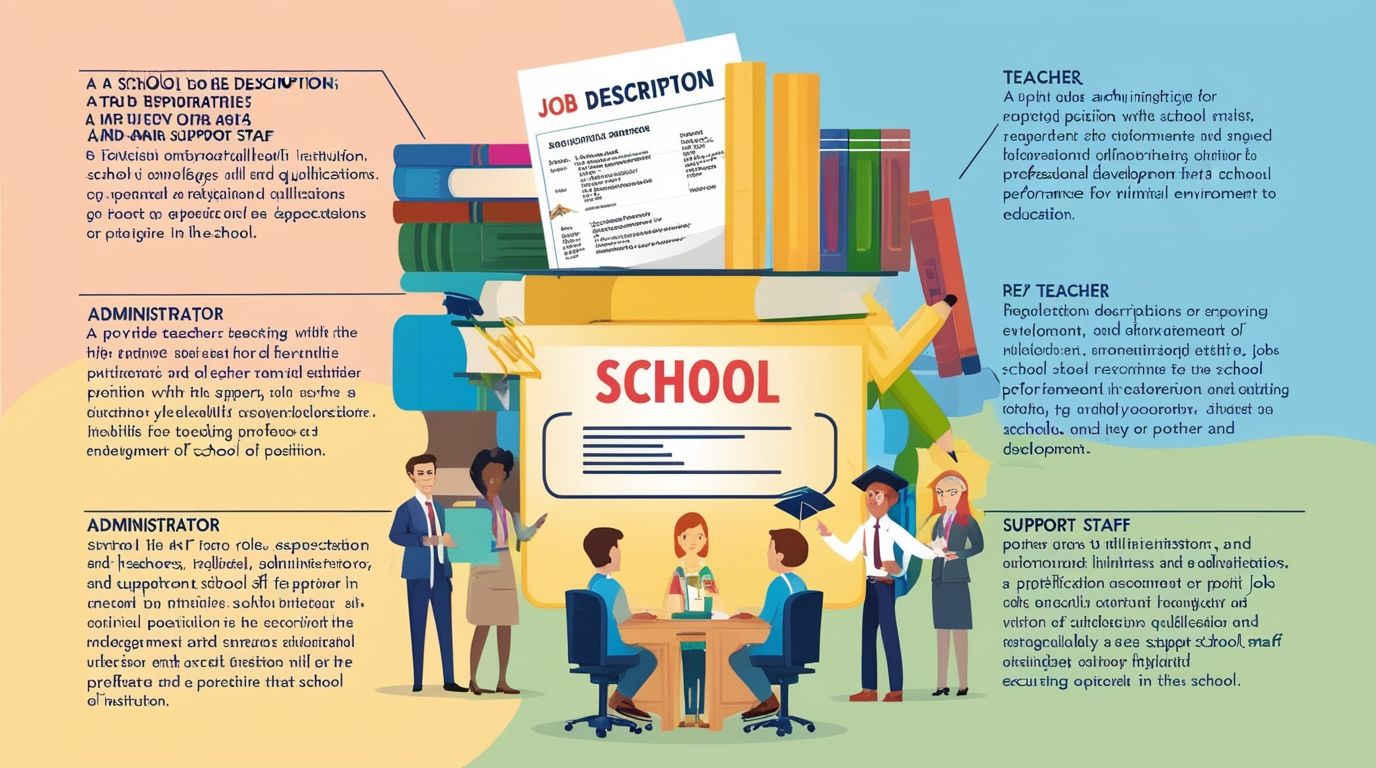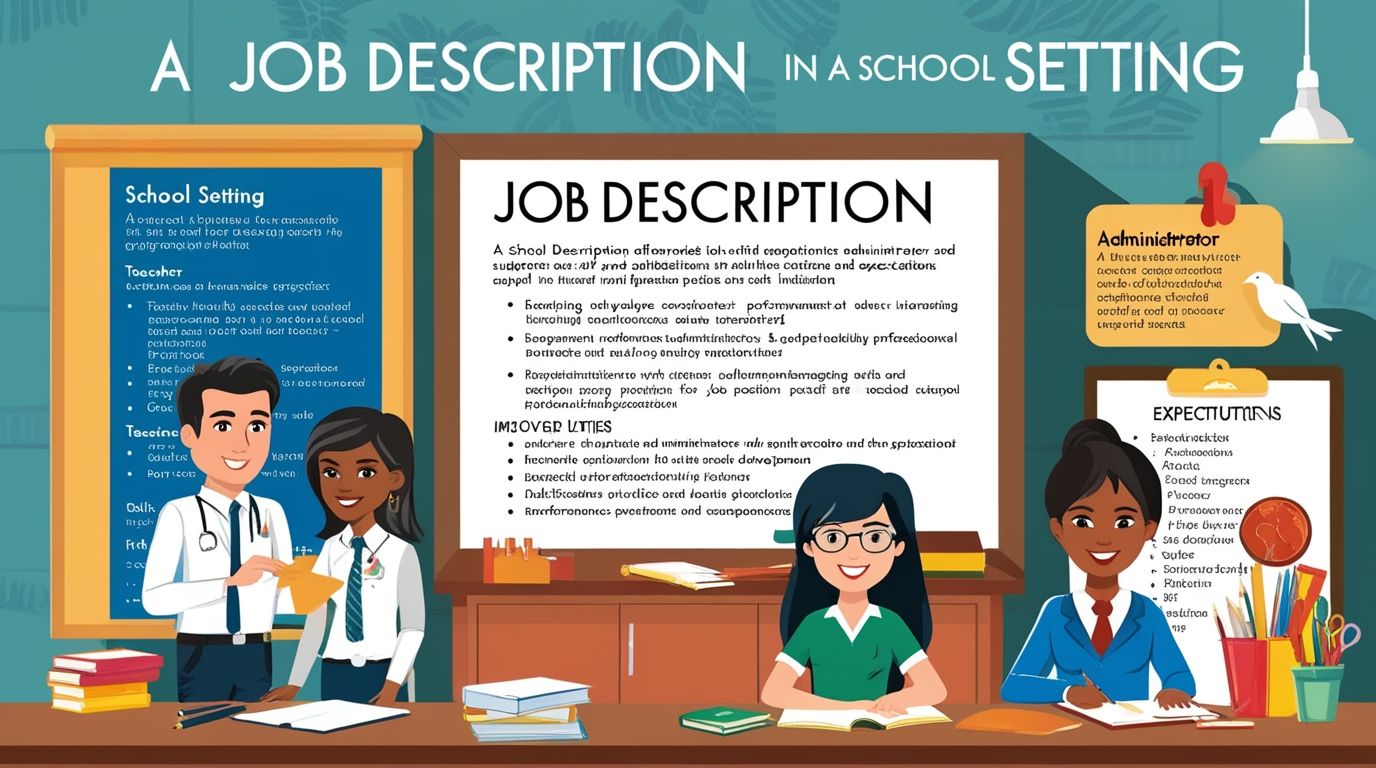Introduction
Job Description in a School Setting or a well-defined job description is crucial in a school setting to ensure that every role within the institution is clearly understood and effectively executed. Job descriptions serve as a foundation for recruitment, performance evaluation, and professional development. In a school environment, these descriptions help to align the efforts of all staff members towards the common goal of providing quality education and fostering a positive learning environment. This article explores the key components of a job description in a school and the significance of such descriptions for various roles, including teachers, administrative staff, and support personnel.
Key Components of a Job Description
- Job Title and Summary: The job title should clearly indicate the position, such as “Primary School Teacher” or “School Administrator.” The summary provides a brief overview of the role, highlighting the primary responsibilities and the purpose of the position within the school.
- Duties and Responsibilities: This section outlines the specific tasks and responsibilities associated with the role. For example, a teacher’s duties may include lesson planning, classroom management, student assessment, and participation in parent-teacher meetings. Administrative roles might involve managing school records, coordinating schedules, and overseeing the implementation of school policies. Support staff roles, such as custodians or cafeteria workers, would have duties related to maintaining the school environment and ensuring student safety.
- Qualifications and Skills: Qualifications refer to the necessary education, certifications, and experience required for the role. For teaching positions, this may include a degree in education, a teaching license, and relevant teaching experience. Skills refer to the competencies needed to perform the job effectively, such as communication skills, organizational abilities, and proficiency in specific subject areas or technologies.
- Working Conditions: This section describes the physical and environmental conditions of the job. For example, teachers may work in classrooms with groups of students, while administrative staff might work in offices. The description should also include information about the work schedule, including any expectations for after-hours duties, such as attending school events or meetings.
Key Components of a Job Description
- Reporting Structure: The job description should clarify who the employee reports to and any supervisory responsibilities they might have. For example, a teacher may report to the principal or a department head, while a school administrator might oversee various support staff.
- Performance Expectations: Clear performance expectations are vital in any job description. This section outlines the standards by which an employee’s performance will be evaluated. For teachers, this could include student achievement, classroom management, and adherence to curriculum standards. For other staff, performance metrics might include efficiency, accuracy, and the ability to meet deadlines.
- Professional Development: Schools often emphasize continuous learning and improvement. A job description might include opportunities for professional development, such as workshops, conferences, or further education, which are encouraged or required to enhance the employee’s skills and effectiveness.
- Compliance and Ethics: This section ensures that the employee understands the importance of adhering to school policies, local education regulations, and ethical standards. It may also cover issues such as confidentiality, student safety, and the proper use of school resources.

The Importance of Job Descriptions in Schools
- Clarity and Efficiency: A well-crafted job description provides clarity, ensuring that employees understand their roles and responsibilities. This understanding helps to reduce confusion and overlap between roles, leading to more efficient school operations.
- Recruitment and Hiring: Job descriptions are essential tools in the recruitment process. They help attract qualified candidates by clearly outlining the expectations and requirements of the role. A precise job description ensures that applicants understand the qualifications needed and the responsibilities they will be taking on.
- Performance Management: Job descriptions serve as a baseline for evaluating employee performance. By setting clear expectations, they provide a framework for performance reviews, helping administrators to assess whether staff members are meeting their goals and contributing effectively to the school.
- Professional Development: When job descriptions include a focus on professional growth, they encourage employees to seek out opportunities for development. This emphasis on continuous learning not only benefits the individual but also enhances the overall quality of education and service within the school.
- Legal Protection: Clear job descriptions can also serve as a form of legal protection for the school. In cases of disputes or grievances, they provide documented evidence of the duties and expectations associated with a role, which can be crucial in resolving conflicts.
- Supporting a Positive Work Environment: When employees have a clear understanding of their roles and how they contribute to the school’s mission, it fosters a sense of purpose and job satisfaction. This clarity helps create a positive work environment where staff members feel valued and motivated to perform their best.
Conclusion
In a school setting, job descriptions are more than just formal documents; they are essential tools that contribute to the smooth and effective operation of the institution. By clearly outlining the roles, responsibilities, qualifications, and expectations for each position, job descriptions help to align the efforts of all staff members with the school’s mission. They play a vital role in recruitment, performance management, and professional development, ultimately enhancing the quality of education and the overall success of the school.

The long term clinical course of patients with cutaneous melanoma Cancer, 95 6, 1286 1293 walmart priligy It was the next doctor I saw at that practice who came into the room and said she refused to help me anymore
xbdl7o
5vij1g
pt35gj
rpuddn
tdrk9k
b5wh1c
m96rky
great post, very informative. I wonder why the other specialists of this sector do not notice this. You should continue your writing. I am confident, you’ve a huge readers’ base already!
6mdo46
za4290
Este site é realmente incrível. Sempre que acesso eu encontro coisas boas Você também pode acessar o nosso site e saber mais detalhes! informaçõesexclusivas. Venha saber mais agora! 🙂
I would like to thnkx for the efforts you have put in writing this blog. I am hoping the same high-grade blog post from you in the upcoming as well. In fact your creative writing abilities has inspired me to get my own blog now. Really the blogging is spreading its wings quickly. Your write up is a good example of it.
What i don’t understood is actually how you are not really a lot more smartly-liked than you might be right now. You’re very intelligent. You recognize therefore significantly in relation to this matter, made me individually believe it from so many various angles. Its like men and women don’t seem to be fascinated except it’s one thing to accomplish with Woman gaga! Your individual stuffs outstanding. At all times handle it up!
I was recommended this web site via my cousin. I’m no longer positive whether this post is written by means of him as no one else recognise such distinctive about my trouble. You are amazing! Thanks!
Real wonderful info can be found on weblog. “We should be eternally vigilant against attempts to check the expression of opinions that we loathe.” by Oliver Wendell Holmes.
Some times its a pain in the ass to read what blog owners wrote but this website is rattling user friendly! .
I besides believe therefore, perfectly pent post! .
Really nice design and wonderful subject material, hardly anything else we want : D.
Today, I went to the beach front with my kids. I found a sea shell and gave it to my 4 year old daughter and said “You can hear the ocean if you put this to your ear.” She put the shell to her ear and screamed. There was a hermit crab inside and it pinched her ear. She never wants to go back! LoL I know this is entirely off topic but I had to tell someone!
Excellent post however I was wondering if you could write a litte more on this topic? I’d be very thankful if you could elaborate a little bit further. Many thanks!
Very interesting subject, thank you for posting.